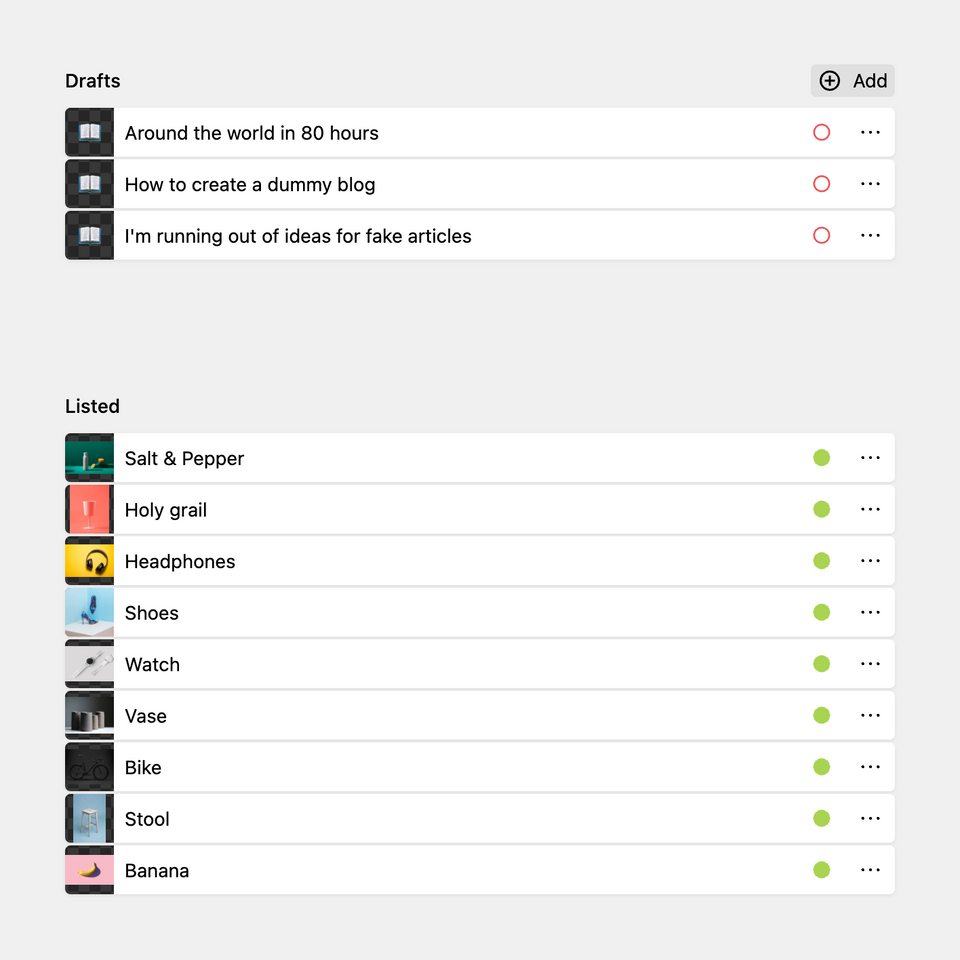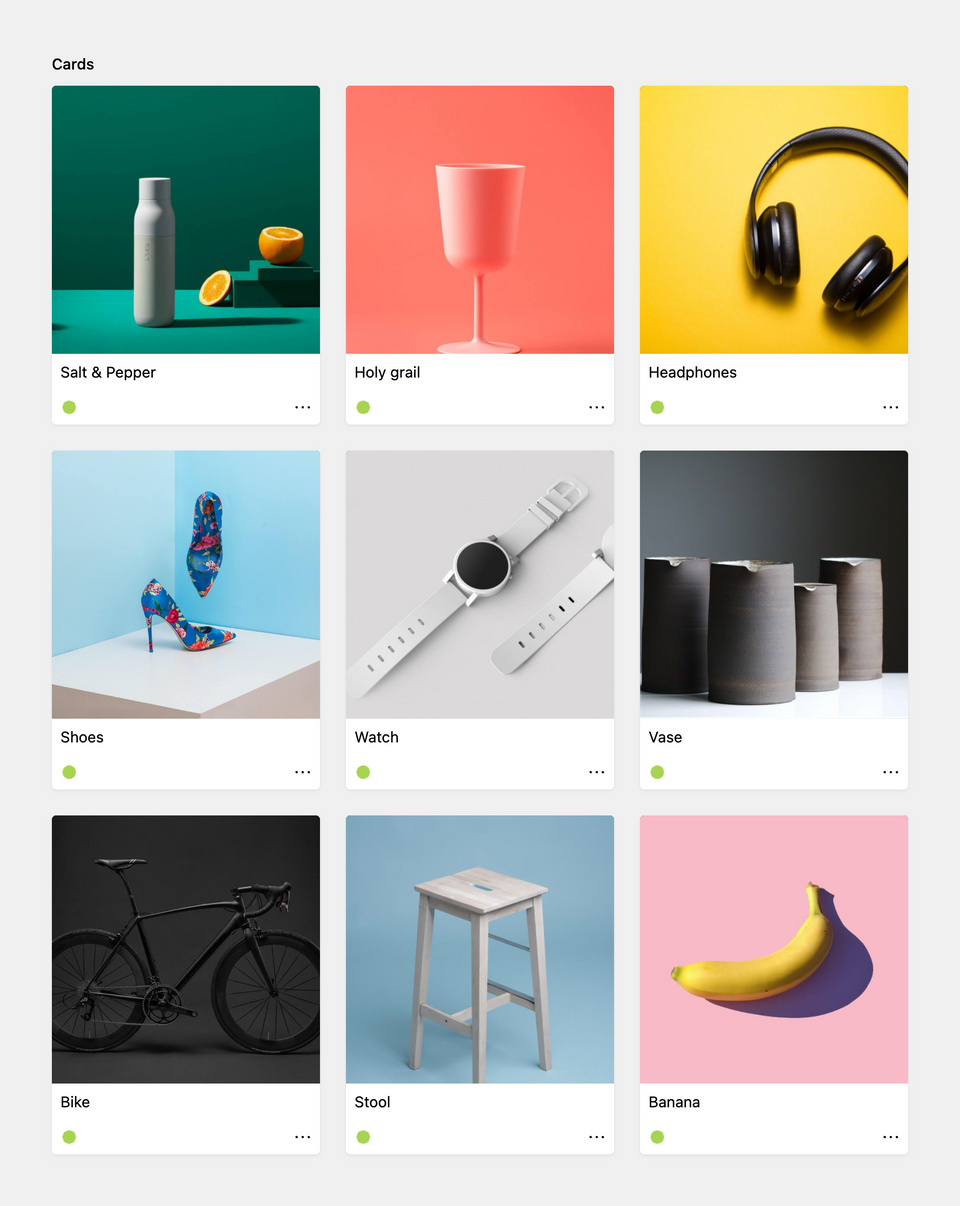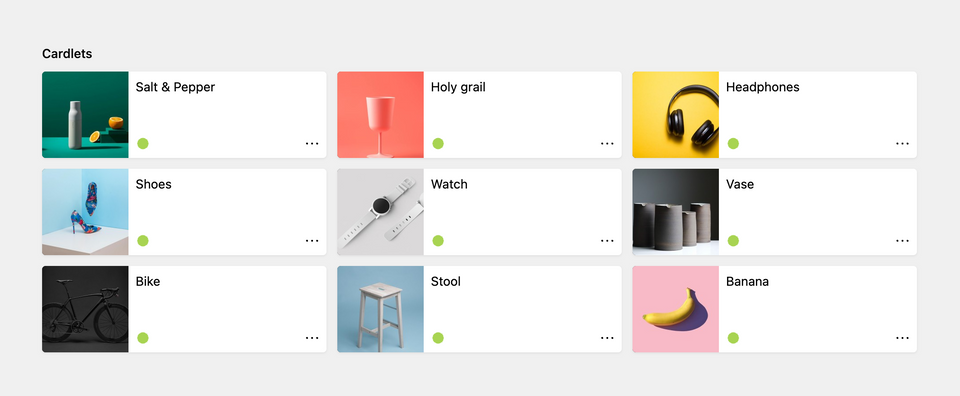Pages section
List and edit subpages
What is a pages section?
A pages section lists the children of a given parent or a set of pages defined by a query. Pages sections also let you do the following operations (if not forbidden or impossible because of other settings):
- create a new page
- delete a page
- change the status of a page
- move a page
- duplicate a page
- change the page slug
- change the page template
- change the order number

Example
title: Shop
sections:
drafts:
label: Drafts
type: pages
status: draft
templates: product
published:
label: Published Products
type: pages
status: listed
templates: productA closer look at pages sections
Show subpages as cards or list, add additional info for each page, control the card design – there are hardly any limits.
Sections do not store anything in the content file, which means that you cannot fetch content from a section in your templates like you would from field content.
Section shortcuts
For simple sections that are only used once per blueprint, you can use shortcuts. In its most basic form, a pages section consists of the section type as name, and true as its value.
sections:
pages: trueThis will add a pages section with all default properties.
These shortcuts can be extended with other section properties as needed, for example:
sections:
pages:
label: Main Pages
status: allKeep in mind that the same section name can only be used once per blueprint.
Section properties
The pages section has multiple options to control what kind of pages should be displayed, how they should be displayed and what happens if a new page is added.
| Name | Type | Default | Description |
|---|---|---|---|
| batch | bool |
false
|
Activates the batch delete option for the section |
| columns | array |
null
|
Columns config for layout: table
|
| create | mixed |
null
|
Optional array of templates that should only be allowed to add or false to completely disable page creation |
| empty | mixed |
null
|
Sets the text for the empty state box |
| flip | bool |
false
|
Enables/disables reverse sorting |
| headline | mixed |
null
|
The headline for the section. This can be a simple string or a template with additional info from the parent page. |
| help | mixed |
null
|
Sets the help text |
| image | mixed |
null
|
Image options to control the source and look of preview |
| info | mixed |
null
|
Optional info text setup. Info text is shown on the right (lists, cardlets) or below (cards) the title. |
| label | mixed |
null
|
The label for the section. This can be a simple string or a template with additional info from the parent page. Replaces the headline prop. |
| layout | string |
'list'
|
Section layout. Available layout methods: list, cardlets, cards, table. |
| limit | int |
20
|
Sets the number of items per page. If there are more items the pagination navigation will be shown at the bottom of the section. |
| max | int |
null
|
Sets the maximum number of allowed entries in the section |
| min | int |
null
|
Sets the minimum number of required entries in the section |
| page | int |
null
|
Sets the default page for the pagination. |
| parent | string |
null
|
Sets the query to a parent to find items for the list |
| query | string |
null
|
Filters pages by a query. Sorting will be disabled |
| rawvalues | bool |
false
|
Whether the raw content file values should be used for the table column previews. Should not be used unless it eases performance issues in your setup introduced with Kirby 4.2 |
| search | bool |
false
|
Enable/disable the search in the sections |
| size | string |
'auto'
|
The size option controls the size of cards. By default cards are auto-sized and the cards grid will always fill the full width. With a size you can disable auto-sizing. Available sizes: tiny, small, medium, large, huge, full
|
| sortBy | string |
null
|
Overwrites manual sorting and sorts by the given field and sorting direction (i.e. date desc) |
| sortable | bool |
true
|
Enables/disables manual sorting |
| status | string |
''
|
Filters pages by their status. Available status settings: draft, unlisted, listed, published, all. |
| template |
arrayorstring
|
null
|
Filters the list by single template. |
| templates | mixed |
null
|
Filters the list by templates and sets template options when adding new pages to the section. |
| templatesIgnore | mixed |
null
|
Excludes the selected templates. |
| text | mixed |
'{{ model.title }}'
|
Setup for the main text in the list or cards. By default this will display the title. |
Label
The label will be displayed above the pages section. You can pass a simple label as a string or you can provide translations for multiple languages, if you have an international editing team.
Single language
label: ArticlesMultiple languages
label:
en: Articles
de: Artikel
es: ArtículosPlaceholders
You can inject information from the current page into the label with template placeholders using our query language.
label: "Articles for {{ page.title }}"Layout
The pages can either be displayed as a simple list or as cards with preview images. The list view is the default view.
List layout (default)
The list layout is perfect for more text-heavy pages, like articles, link lists, simple pages, etc.
layout: list
Cards layout
The card layout is great for media-heavy pages, like galleries, products, projects, etc.
layout: cards
Cardlets layout
The cardlets layout is great for nice visual previews of files, while your text content is still representend decently.
layout: cardlets
Table layout
The table layout has the highest information density. Columns can be fully customized and make it perfect if you need to show multiple values at once for better overview and scannability.

layout: tableThe table layout will show the preview image together with a title and info column based on your text and info settings. You can switch off those automatic columns with image: false, text: false and info: false if you want to introduce your own columns.
Columns
Custom table columns can be defined with the columns option.
layout: table
columns:
subheading: true
date: trueEach column can be customized with additional settings:
Label
layout: table
columns:
subheading:
label: SubheadingTranslated label
layout: table
columns:
subheading:
label:
en: Subheading
de: UnterüberschriftAlignment
Text alignment can be left (default), center or right.
layout: table
columns:
subheading:
label: Subheading
align: rightWidth
The column width can be set with the width property. You can use the usual fractions:
layout: table
columns:
info: false
subheading:
label: Subheading
width: 1/3
title:
width: 1/3
date:
width: 1/6
tags:
width: 1/6Value
By default, the table cells contain the field value matching the column name. You can customize the value with a string template.
layout: table
columns:
date:
label: Date
value: "on {{ page.date.toDate('d.m.Y') }}"
type: textIf the page actually has a date field of type date, Kirby will automatically use the date field preview component for this column. However, this will clash with your custom value. This is why we also set type: text.
HTML
Values are converted to safe HTML by default. This is the most secure way to handle content in your Panel. If you know what you are doing and you want to render HTML in a table cell, you can use the html option to stop HTML from being auto-encoded.
layout: table
columns:
html:
label: HTML
type: html
value: "{{ page.someSafeHTML }}"Mobile
Set the mobile option to true for a column to be visible in the mobile view.
layout: table
columns:
subheading:
label: Subheading
mobile: trueType
To display different content, you can use column types to improve the preview of your data, e.g. text, url, tags.
Check out the field previews in our Lab to get an overview of the various previews that can be used as column types.
Customizing default columns
layout: table
info: "{{ page.slug }}"
columns:
title:
label: Custom title label
info:
label: Custom slug label
width: 10remPage information
You can fine-tune the display text and additional information for every page in the list with the text and info options.
text
By default the page title is shown in the list for every page. You can use our template syntax with query language to fetch any information from the page and display that instead of the title.
text: " {{ page.title.upper }}"info
If you want to display additional information for each page, like a date, year, category or any other field value, you can use the template syntax with query language in the info option.
info: " {{ page.date.toDate('Y-m-d') }}"Preview images
The (preview) image for each item in the list is by default what is configured in the respective page blueprint. However, you can customize these further for your section with the same options as in the page blueprint:
type: pages
image:
query: page.cover.toFile
icon: 📝
back: blue-700
color: white
cover: trueEmpty state
With the empty option you can define the message which is displayed when no pages are listed in the section.
empty: No articles yetFiltering pages
Parent
By default, the current page is being used as the parent to find children for the list. With this option, any page on your site can be the parent of the section
parent: site.find("blog")query
The pages section supports a query option to filter the pages that are shown in a section using our query string syntax. Manual sorting will be disabled for sections with a query.
videoPosts:
type: pages
label: Video posts
query: page.childrenAndDrafts.filterBy('category', 'video')
template: article
otherPosts:
type: pages
label: Other posts
query: page.childrenAndDrafts.filterBy('category', '!=', 'video')
template: articleThe query option cannot only be used in the context of a single page, but you can also query the complete site index if that makes sense, for example in site.yml:
siteIndex:
type: pages
query: site.index(true).notIn(['error'])
create: defaultStatus
You can filter the list of pages by their status. The available status values are
| Status | Description |
|---|---|
draft |
Only drafts will be shown |
listed |
Only listed pages (with a sorting number) will be shown |
unlisted |
Only unlisted pages (without a sorting number) will be shown |
published |
Listed and unlisted pages will be shown |
all (default) |
Drafts, listed and unlisted pages will be shown |
status: draftNote that an "Add" button for new pages will only be available if you use either status: draft or status: all.
Templates
You can define a list of templates that will be available when adding new pages to the section. It will also be used to filter pages to be contained in the list.
Single template
template: articleMultiple templates
templates:
- project
- articleIf only one template is available when adding a new page, the template select will be hidden in the dialog (except when the debug option is active).
"Add" button
Editors can add new pages to the section with the "Add" button in the top right corner.
status: all |
status: draft |
status: listed |
status: unlisted |
|---|---|---|---|
| + Add | + Add |
The add button will only show up if the status option is set to draft or all
Why?
New pages are always added as draft. If the "Add" button showed up in sections that only show listed or unlisted pages, the "Add" button would lead to a confusing interaction for editors, as the new page would not show up in the section.
Since 5.0.0
Batch delete pages
When managing many pages, it can be tedious to delete them one by one. Adding batch: true, allows you to select multiple pages and delete them at once.
notes:
type: pages
batch: trueSorting
sortBy
You can sort the list of pages by one or more fields/properties in descending or ascending order.
sortBy: date desc
sortBy: date desc title asc
sortBy: status desc year descYou can pass PHP sorting type flags, for example to make sorting work with special language specific characters.
sortBy: title SORT_LOCALE_STRING
sortBy: title asc SORT_LOCALE_STRINGThe sortBy option only has an effect on the display order inside this section in the Panel. Because all pages will always be sorted by the field/property you defined, manual drag and drop sorting inside the section is disabled.
However each page can still have its own sorting number, which can be controlled via the page status dialog. If you don't need or want the custom sorting numbers, you need to disable them with the num option of the child page blueprint.
flip
Use the flip option to enable/disable reverse sorting (default is false):
sortBy: title
flip: truesortable
You can switch off manual sorting entirely with the sortable option.
sortable: falseLimits
limit
The limit property sets how many pages will be shown per page. If there are more entries in the section, the pagination navigation will be shown at the bottom of the section.
limit: 20max
You can define a maximum number of pages, that will be allowed in this section. After the maximum is reached, the add button will be hidden and no more pages can be added.
max: 10min
You can also define the minimum number of pages, that need to be added in order to make the page valid.
min: 2Conditional sections
Like conditional fields, sections can be shown/hidden based on the value of a given field (i.e. if a toggle is checked, a select field is at a certain option, etc.).
The condition for displaying the section is set with the when option. In the when option you define a field name as the key and the required value of that field. In the following example, the each section type is shown based on a different value of the postType field:
sections:
content:
type: fields
fields:
postType:
type: select
options:
- Gallery
- Image
- Text
gallery:
type: files
template: gallery-image
layout: cards
size: tiny
when:
postType: Gallery
image:
type: files
template: single-image
max: 1
layout: cards
when:
postType: Image
text:
type: fields
fields:
text:
type: textarea
tags:
type: tags
when:
postType: TextSearch

Section search is disabled by default. You can use the search option to enable it.
sections:
drafts:
type: pages
search: trueBuild a bookmark tool
An example how to build a nice overview with the table layout in the pages section showing all relevant columns.

